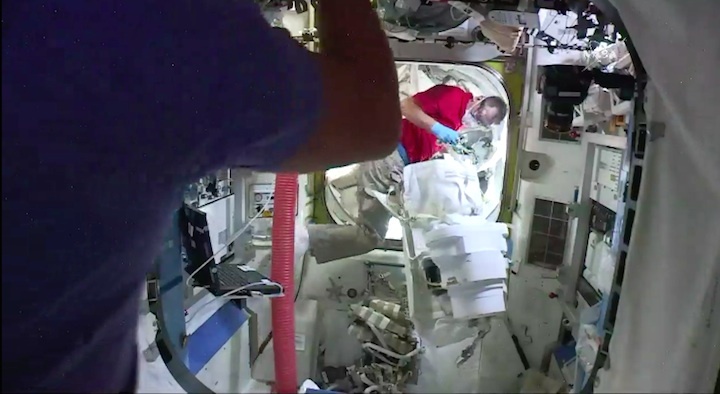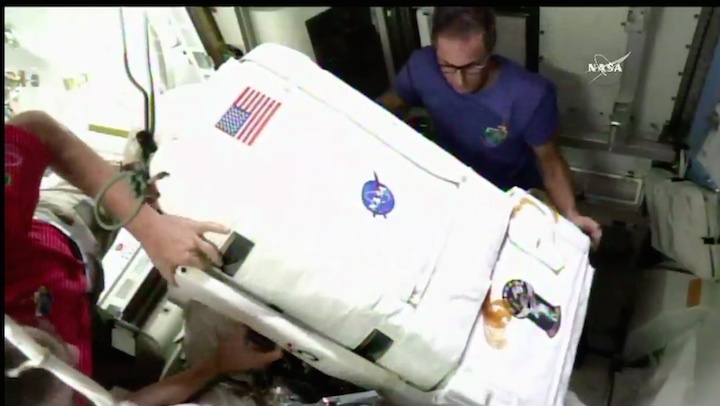10.10.2017

Two Astronauts Begin Second Spacewalk of Mission

NASA astronaut Randy Bresnik (bottom center) is dwarfed by a set of basketball court-sized solar arrays and the Earth in the background during a spacewalk on Oct. 5, 2017.
Two NASA astronauts switched their spacesuits to battery power this morning at 7:56 a.m., EDT aboard the International Space Station to begin a spacewalk planned to last about 6.5 hours. Live coverage is available on NASA Television and the agency’s website.
Expedition 53 Commander Randy Bresnik and Flight Engineer Mark Vande Hei of NASA will lubricate components of the new latching end effector they installed on the Canadarm2 robotic arm in their first excursion Oct. 5. They will also replace a faulty camera system in the 204th spacewalk in support of assembly and maintenance in station history. This is the fourth spacewalk of Bresnik’s career and the second for Vande Hei.
A third spacewalk to continue the lubrication of the new end effector and to replace another camera system on the Destiny Lab is planned for Bresnik and Flight Engineer Joe Acaba of NASA Oct. 18.


+++

















Quelle: NASA
+++
Spacewalkers continue LEE tasks on station’s robotic arm

Two spacewalkers again stepped outside the International Space Station (ISS) on Tuesday to continue to perform vital maintenance on the Space Station Remote Manipulator System (SSRMS), via replacing and lubing one of its Latching End Effectors (LEE). After EVA-44 replaced the LEE with time to spare, EVA-45 was dedicated to lubing the new hardware.
LEE overview:
The LEE allows the SSRMS to grapple onto objects, and the SSRMS has one LEE on each of its ends, in order to enable the SSRMS to relocate itself around the ISS via so-called base changes.

The LEE features three snares which close around a grapple pin on target objects, in the same way that the Space Shuttle’s robotic arm used to work. This enables the LEE to grapple any object which features a Flight Releasable Grapple Fixture (FRGF) interface.
However, the LEE also has some more complex features due to the fact that it was designed for long-terms use on the ISS. Specifically, it features latches, which allow it to securely clamp itself onto compatible Power & Data Grapple Fixture (PDGF) interfaces, and also electrical and data interfaces which can connect the arm to the object it has grappled.
This latching capability allows the arm to tightly hold onto the ISS wherever it is based, whilst reducing wear on the snares, and the electrical and data interfaces allows for command & control of the arm, whilst also enabling the arm to provide power to objects it has grappled.

ISS teams have been tracking some degradation of performance in both LEEs for several years now – specifically, increasingly high motor currents have been required in order to extend the latches. This in itself is not unexpected, and the LEEs were designed for an orbital lifetime of 10-15 years, and have currently been on-orbit for 16 years.
The LEE is a very complex electro-mechanical system which can be subject to significant forces, and since they are such acritical components in enabling ISS operations (for example the capture of cargo vehicles), a change-out of a LEE has been in planning by the ISS teams for several months now.
Originally, it was LEE-B that was planned to be replaced. However, in August this year an incident occurred where LEE-A’s latch motors stalled during the latching process, which thus required more force to complete the latching process. This occurrence had never been seen before on the ISS.

As detailed in L2 notes at the time: “During an attempt to walk off the SSRMS to MBS PDGF 3, an attempt to capture failed due to a LEE-A latch mechanism motor stall at 3.39A. Subsequent capture attempts failed with a similar signature”.
“MBS PDGF 3 was then released and a SSRMS LEE checkout was performed in free space. During the checkout, the LEE mechanism had a running current of ~0.9A and peak current of 1.9A. Due to the unexpectedly high current seen during the unloaded checkout, the team stood down from SSRMS operations.”
This is considered a concerning event, as a failure to latch the SSRMS would prevent the arm from being able to change its base, since the latches must first extend to rigidly lock the SSRMS onto the ISS, following which the electrical connectors (which are behind the latch doors) extend to provide power/data for command and control.
Due to this fact, a latch failure would also prevent the SSRMS from being able to provide power to any object it has grappled, for example, Orbital ATK’s Cygnus vehicle, which requires power from the SSRMS following grapple.
As such, ground teams felt that LEE-A presented more of a concern than LEE-B, and thus the plan was changed to replace LEE-A rather than LEE-B.
LEE-A will not actually be replaced with a brand new spare (although one does exist on the ISS), but rather will be swapped with an identical unit on the Payload ORU Accommodation (POA) on the Mobile Base System (MBS). The POA is only rarely used as a temporary stowage location, and as such its LEE has seen much less wear and tear than the SSRMS LEEs.
In future, this LEE will be brought inside the ISS and returned to Earth inside a SpaceX Dragon vehicle for refurbishment and re-flight. An additional spacewalk will also be performed in early 2018 to replace LEE-B with the spare unit on the ISS.
EVA procedures:
The opening EVA involved NASA astronauts Randy Bresnik and Mark Vande-Hei. Vande-Hei was making his first spacewalk during EVA-44.

The first order of business once egressing the Quest airlock was for both spacewalkers to translate to the worksite on the front side of the P1 Truss, where the SSRMS has been pre-positioned for access.
After setting up the worksite, the spacewalkers began by removing two Multi-Layer Insulation (MLI) blankets near the LEE, in order to expose six Expandable Diameter Fasteners (EDFs) which hold the LEE onto the rest of the arm.
These fasteners, as their name implies, expand as they are being tightened in order to ensure a very tight fit. It is for this reason that there was some potential difficulty in releasing these fasteners, due to their age and the forces they have been subjected to over the years. However, no major issues were noted during this procedure.

A LEE has been removed on-orbit before, on STS-111 in 2002, during change out of an SSRMS wrist roll joint. This has provided a roadmap for this latest EVA.
The spacewalkers then released two EDFs, following which the LEE was rotated to enable access to the remaining four bolts. The arm was then powered off, following which the spacewalkers removed the remaining four bolts, which released the LEE from the SSRMS.
The spacewalkers then temporarily stowed the removed LEE, and proceeded to remove six EDFs from the POA, in order to detach its LEE.
The LEE was removed from the POA was then installed onto the SSRMS in a reverse of the above procedure, following which the LEE which was removed from the SSRMS and re-installed onto the POA for long-term stowage.
With the task completed in good time, the spacewalkers set out to complete some get-ahead tasks, including the replacement of MLI blankets on ESP-2.
The spacewalkers then returned to the airlock to conclude the EVA.

The second EVA on Tuesday repeated the egress procedures, with Bresnik joined by Vande Hei.
The second spacewalk was largely devoted to lubricating the newly installed end effector and replacing cameras on the left side of the station’s truss and the right side of the station.
The camera assembly is responsible for the pink hue seen during the arrival and departure of Visiting Vehicles and required replacing.
The HD Cam which has provided stunning views of these events was relocated and successfully checked out, while the faulty camera was stowed in a crew lock bag.

Vande Hei dedicated a large portion of the second half of the EVA by applying grease to the ball screws and latches on the LEE that was installed on EVA-44.
The task has provided no significant issues, with the spacewalk between 45 minutes and one hour ahead of schedule, with consumables allowing for a spacewalk that could last up to seven hours.
Such was the efficiently of the spacewalk, several lube tasks scheduled for EVA-46 next week were added to EVA-45.
A few get-aheads, relating to handrails and insulation were also completed ahead of the EVA coming to a close.
Quelle: NS
